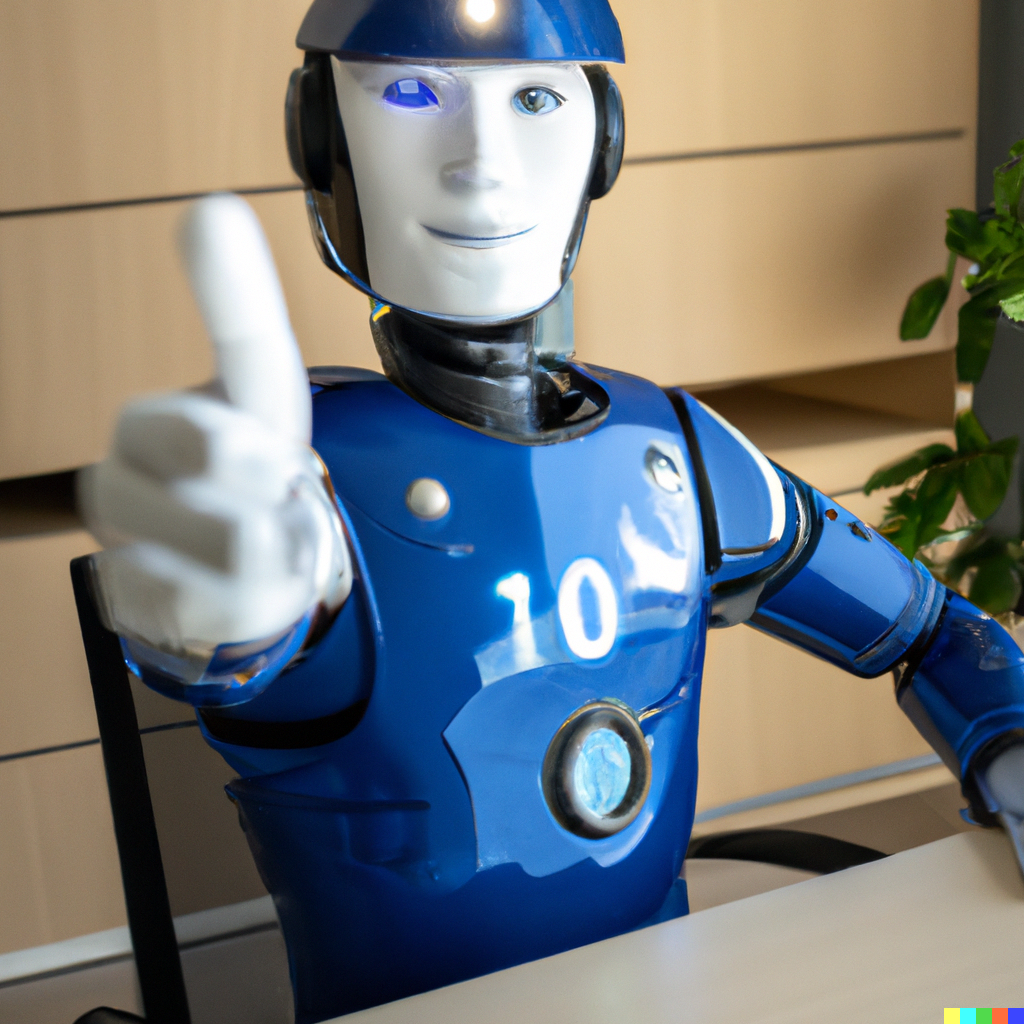Technical Background
Written and illustrated by AI
This blog was written by OpenAI, using the AI ContentWriter plugin for WordPress.
The prompt given was merely the title “Creating AI Law” Writing Style was set to “Persuasive” and Tone was set to “Formal”. Headings were generated by OpenAI. It was set to write introductory and concluding paragraphs.
Image by DALL E, using prompt “a robot policeman in a blue uniform pointing at the viewer in an office photorealistic.” Around 24 images and 6 alternative prompts were used before the human selected this image.
Introduction
Using the law to control AI is becoming an increasingly important issue as the technology becomes more prevalent in many aspects of life. AI technology is being used in a variety of applications, from healthcare to robotics, and even in self-driving cars. With its rapid growth, legal and regulatory frameworks are needed to ensure that AI technology is used responsibly and ethically. This article will discuss how laws and regulations can be used to manage AI, and how these laws can be enforced. It will also discuss the potential risks of using AI technology, and how those risks can be managed through legal frameworks. Finally, it will explore the potential for AI to help create a more equitable and just society.
Understanding the Ethical and Regulatory Implications of AI
As AI technology continues to grow in ubiquity, it is essential to understand the ethical and regulatory implications that accompany it. AI is a powerful tool and its potential to transform our lives is immense. However, this potential must be balanced with caution and ethical considerations. When developing AI systems, it is important to consider the potential implications of their use. AI systems can be used to make decisions that may have far-reaching consequences and it is essential to ensure that these decisions are made ethically. This means considering the safety, privacy, and fairness of the decisions that the AI will make. It is also important to understand the regulatory implications of AI. AI technology is changing rapidly, and governments and regulatory bodies must keep up with this change in order to ensure that AI is used responsibly. Regulations must be in place to ensure that AI is used ethically and that it is not used to harm people or manipulate them. AI has the potential to revolutionise the world and its use should be encouraged. However, it is important to understand the ethical and regulatory implications that accompany it. It is essential that AI is used responsibly and ethically, and this understanding starts with understanding the ethical and regulatory implications that come with its use.
Using the Law to Protect Consumers from AI-Generated Harm
As artificial intelligence (AI) continues to become more pervasive in our lives, it is important to consider how to protect consumers from potential harms caused by AI-generated decisions. The law has an important role to play in safeguarding consumers from the potential harms caused by AI. First and foremost, it is essential to ensure that AI-generated decisions are transparent and can be audited. Companies should be required to disclose the algorithms they use to generate decisions, allowing consumers to understand how the decisions are being made. This can also help to identify any potential bias that could be causing unfair treatment of consumers. Second, companies should be held liable for any harms caused by AI-generated decisions. This would provide an incentive for companies to ensure that their algorithms are producing fair and accurate decisions. If a company fails to adequately monitor their AI-generated decisions, they should be held liable for any resulting harm. Finally, companies should be required to provide consumers with a remedy if they are harmed by AI-generated decisions. This could take the form of a court-supervised process or an independent dispute resolution process. Consumers should be able to receive compensation for any actual losses suffered as a result of AI-generated decisions. Overall, the law can play an important role in protecting consumers from AI-generated harms. By ensuring transparency, holding companies liable, and providing remedies, the law can help to safeguard consumers and ensure that AI-generated decisions are fair and accurate.
How the Law Can Help Combat AI-Driven Discrimination and Bias
The use of artificial intelligence (AI) is rapidly increasing in every aspect of our lives, from healthcare to finance. However, AI systems can be susceptible to discrimination and bias, and if not addressed, these issues can have significant consequences. As such, it is essential that the law be used to combat AI-driven discrimination and bias. At the core of the law’s ability to combat AI-driven discrimination and bias is the concept of due process. By guaranteeing individuals the right to challenge decisions made by AI systems, due process ensures that those affected by these systems can seek redress if they believe that their rights have been violated. This can be done through a process of review, which allows individuals to present evidence and challenge the accuracy or fairness of the AI system’s decision. The law can also be used to ensure that AI systems are held accountable for their decisions. In particular, legal requirements can be put in place to ensure that AI systems are regularly audited and tested for potential bias, and that the data used to train them is accurate and unbiased. This can help to ensure that AI systems are not only operating in accordance with the law, but also that they are not discriminating against individuals or groups. Finally, the law can be used to ensure that individuals are aware of the potential risks of AI-driven discrimination and bias. For example, legal requirements can be put in place to ensure that individuals are informed of their rights when interacting with AI systems, and that they have access to resources to help them understand the potential implications of AI-driven decisions. In conclusion, the law has a crucial role to play in combating AI-driven discrimination and bias. By guaranteeing individuals the right to due process, holding AI systems accountable for their decisions, and ensuring that individuals are informed of the potential risks of AI-driven discrimination and bias, the law can help to ensure that individuals are treated fairly and that their rights are respected.
How the Law Can Help Shape the Development and Use of AI
The development and use of artificial intelligence (AI) can have profound implications for our society and the way we live our lives. As such, it is essential that we use the law to ensure that the development and use of AI is carried out in an ethical and responsible manner. The law can help to shape the development and use of AI in several ways. Firstly, the law can be used to help regulate the processes of AI development. This could include ensuring that developers are following best practices and standards for ethical AI development, as well as putting in place laws that govern the use of data and algorithms in AI applications. Secondly, the law can also be used to ensure that AI applications are used responsibly. This could include setting out restrictions on the use of data, algorithms, and AI applications, and creating laws that ensure that AI applications are used in a fair and transparent manner. Thirdly, the law can be used to ensure that the development and use of AI is carried out in a manner that is consistent with broader societal values. This could include creating laws that ensure that AI applications are not used to discriminate against certain groups of people, or laws that ensure that AI applications are used in a manner that respects human rights. Finally, the law can be used to create a framework for the governance of AI applications. This could involve setting out rules and regulations that govern how AI applications are developed, used, and maintained. This could also involve creating laws that create liability for developers and users of AI applications in the event that any harm is caused as a result of their use. Overall, the law can be used to help shape the development and use of AI in order to ensure that it is used in an ethical and responsible manner. By using the law to regulate the development and use of AI, we can help ensure that AI is used in a manner that is consistent with our broader societal values and that respects the rights of all individuals.
The Legal Implications of Autonomous AI Systems
Autonomous AI systems are increasingly becoming an important component of modern society, with applications in many different industries. However, there are significant legal implications that need to be considered when utilizing this technology. The primary legal issue concerning autonomous AI systems is the potential for liability. In the event of an accident or other issue, it is unclear who, if anyone, may be held responsible. This is particularly concerning when AI systems are used in safety-critical applications, such as self-driving cars or medical robots. Another legal issue is the potential for AI systems to be used in an unethical or illegal manner, such as using facial recognition software to monitor citizens without their knowledge or consent. In addition, there is the potential for AI systems to infringe on existing laws, such as copyright and patent laws. AI systems may be designed to generate content or products that are similar to existing works, which could potentially be a violation of copyright law. Additionally, AI systems may be designed to patent ideas or processes, which could lead to disputes over ownership of the technology. Finally, there is the potential for AI systems to become too powerful or too intelligent for humans to control. This could lead to a host of ethical and legal issues, such as AI systems becoming independent decision-makers or gaining too much control over people’s lives. As AI systems become more prevalent, it is essential that the legal implications of their use are carefully considered. Governments, corporations, and individuals should all take steps to ensure that AI systems are used in a responsible and ethical manner. It is also important to ensure that any potential legal issues are addressed before they arise, as the consequences of an AI-related legal dispute can be costly and difficult to resolve.
Conclusion
The use of law to control AI has the potential to be a powerful tool in protecting the public from the harms that AI can cause. However, it is important to recognize the limitations of using law to control AI, such as the difficulty in keeping up with the rapidly changing technology, the challenge of setting clear standards and guidelines, and the risk of over-regulating the technology. Ultimately, the use of law to control AI should be used in combination with other methods, such as education and ethical frameworks, to ensure that AI is used responsibly and ethically.

